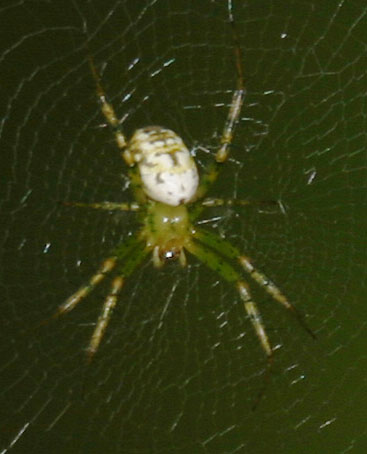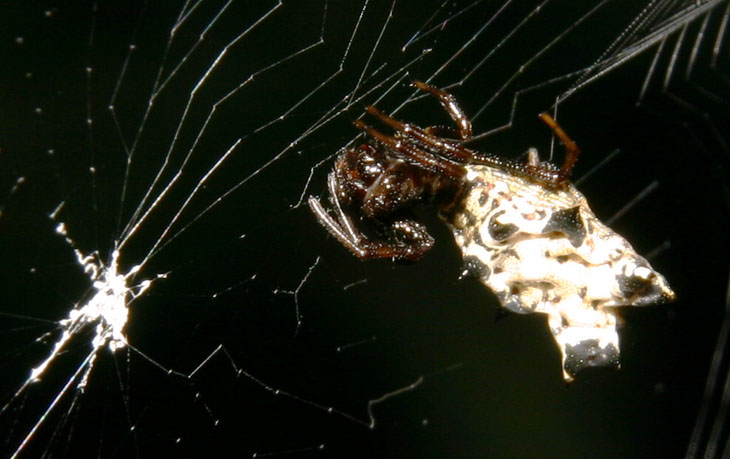Since Rayl asked yesterday in the comments about what made the web in the previous post, I revisited the river to see if I could find out more specifics. This isn’t as big a deal as you might think; the river is two miles away and the path an easy hike, plus I like practicing for subject assignments. What wasn’t easy was locating more of the same webs, since the conditions this morning weren’t foggy or cool, so virtually all webs were completely invisible. I may have walked under several and never known it.
 But, I think I’ve pinned down the responsible party, pending further confirmation. The little spud seen here had a web too far above my head, and while not horizontal, it was leaned over at nearly 45 degrees and the right size. This would appear to be a Mangora spiculata, which doesn’t seem to have a “common” name. This link gives some identifying characteristics to differentiate it from M. maculata. This specimen is roughly 8-10mm in body length, the “orb” portion of the web itself roughly 40-50cm.
But, I think I’ve pinned down the responsible party, pending further confirmation. The little spud seen here had a web too far above my head, and while not horizontal, it was leaned over at nearly 45 degrees and the right size. This would appear to be a Mangora spiculata, which doesn’t seem to have a “common” name. This link gives some identifying characteristics to differentiate it from M. maculata. This specimen is roughly 8-10mm in body length, the “orb” portion of the web itself roughly 40-50cm.
Another image can be found here. Because of the height and conditions, I was working from a short distance with the 135-400 lens and an extension tube, and trying to judge a decent flash exposure – in other words, the pics could have been better, but not without a stepladder and more equipment ;-).
I’ll take this opportunity to segue into the fun of spider photography. Usually, your subject is so small in the viewfinder that standard TTL “smart” flashes can’t get a decent reading from them, and instead attempt to illuminate the background, which may be too far away to accomplish this. It means that the camera and flash conspire to blast out maximum light, often overexposing your subject and practically setting fire to the web (okay, I’m exaggerating a tad.) Among many other settings, the Metz MZ 40-3i has a flash compensation switch, which allowed me to reduce the lighting to manageable levels despite the TTL settings. If you can arrange it, holding a branch or some medium-toned object immediately behind the web can give the camera something to expose for and provide contrast for the details of the spider to stand out.
In addition, spiders are three-dimensional subjects (go figure) that require a high depth-of-field at macro magnifications lest some portion of them go too far out of focus, which means a small aperture and thus reduction of the light, requiring more flash power. Trying to do such shots without a flash is simply asking for a frustration-induced stroke, since spiderwebs move with the tiniest of breezes and constantly shift in and out of focus. You will want the instant response of a flash-illuminated image, as slower shutter speeds means the spider will simply ride back and forth while the shutter is open and produce some form of modern art.
If you really want to have fun, you can attempt to snag a fast-moving Spined Micrathena (Micrathena gracilis) as it builds a new web. They’re very cooperative in that they usually construct their webs at eye-level, and provided you spot them before you walk through the webs you’ll often have a decent shot at good closeups. Of course, the shiny black and white bodies mean proper exposure is quite a challenge, especially with nothing in the background. The frequency of this species in the area is responsible for my typical practice of walking through the woods waving my Harry Potter wand in front of me, muttering “Ensnarum dispersus” under my breath. See another pic, also from today, right here. This specimen is roughly 5mm in length.

So, what better time to relate this story? When I lived in Florida, I did a fair bit of bike riding at night to get to interesting areas for night exposures. The rural sidewalks and bike paths made this quite easy, but there were some disadvantages. One night I passed through an orb-weaver’s web so large I felt it across my entire upper torso, from chin to wrist. I am only slightly more self-possessed than the average person when this happens, and managed not to crash screaming, but I did stop under a streetlight and hurriedly flick off the massive brown spider that was crouched on my shoulder following my rude collision. A few minutes later, I got to the lake where I wanted to do some time exposures and slung the tripod off of my back, only to shake off another spider who bounced off my wrist. This one was large enough to actually be felt when it impacted, and probably better than 15mm in body length – in other words, almost the size of a quarter without counting the legs. And naturally I was pulling webs off for the next hour.
Sorry, I promised fluffy bunny pics a while back, didn’t I? I’ll try harder, I promise.




















































